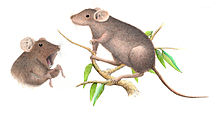Apomys
| Apomys Temporal range:
| |
|---|---|

| |
| Large Mindoro forest mouse (Apomys gracilirostris) | |
| Scientific classification | |
| Domain: | Eukaryota |
| Kingdom: | Animalia |
| Phylum: | Chordata |
| Class: | Mammalia |
| Order: | Rodentia |
| Family: | Muridae |
| Tribe: | Hydromyini |
| Genus: | Apomys Mearns, 1905 |
| Type species | |
Apomys hylocetes
, 1905 | |
| Species | |
|
| |
Apomys, commonly known as earthworm mice, is a genus of rodent endemic to the Philippines. Mice belonging to this genus are generally called Philippine forest mice and can be found on most islands of the Philippines except in Palawan, the Sulu Archipelago, and the Batanes and Babuyan group of islands.
Apomys mice weigh from 18g to 128g. The tail is longer or nearly equal the length of the head and body. The soft and thick fur of these mice is darker on the back while the front fur is paler, often nearly white with a moderate orange yellow wash. The hind feet are moderately long and narrow, have six plantar pads, and have digits 2–4 notably longer than digit 5 and the hallux. All species have two pairs of inguinal mammae.[1]
Species
Nineteen species are known in two subgenera:[2][3][1][4]
- Subgenus Apomys - smaller, arboreal species
- Camiguin forest mouse, A. camiguinensis Heaney & Tabaranza, 2006
- Mount Apo forest mouse, A. hylocoetes Mearns, 1905
- Mindanao montane forest mouse, A. insignis Mearns, 1905
- Mindanao lowland forest mouse, A. littoralis Sanborn, 1952
- Small Luzon forest mouse, A. microdon Hollister, 1913
- Least forest mouse, A. musculus Miller, 1911
- Subgenus Megapomys - larger, ground-living species
- Luzon Cordillera forest mouse, A. abrae Sanborn, 1952
- Luzon Aurora forest mouse, A. aurorae Heaney, Balete, Alviola, Duya, Veluz, VandeVrede & Steppan, 2011
- Mount Banahaw forest mouse, A. banahao Heaney, Balete, Alviola, Duya, Veluz, VandeVrede & Steppan, 2011
- Mount Tapulao forest mouse, A. brownorum Heaney, Balete, Alviola, Duya, Veluz, VandeVrede & Steppan, 2011
- Luzon montane forest mouse, A. datae Meyer, 1899
- Large Mindoro forest mouse, A. gracilirostris Ruedas, 1995
- , Veluz, Steppan, Esseltyn, Pfeiffer & Rickart, 2014
- A. lubangensis Heaney, Balete, Veluz, Steppan, Esseltyn, Pfeiffer & Rickart, 2014
- Luzon giant forest mouse, A. magnus Heaney, Balete, Alviola, Duya, Veluz, VandeVrede & Steppan, 2011
- Mount Mingan forest mouse, A. minganensis Heaney, Balete, Alviola, Duya, Veluz, VandeVrede & Steppan, 2011
- Long-nosed Luzon forest mouse, A. sacobianus Johnson, 1962
- Sierra Madre forest mouse, A. sierrae Heaney, Balete, Alviola, Duya, Veluz, VandeVrede & Steppan, 2011
- Luzon Zambales forest mouse, A. zambalensis Heaney, Balete, Alviola, Duya, Veluz, VandeVrede & Steppan, 2011
Several species also awaits formal description.
The species generally inhabit narrow ecological niches with small endemic ranges.
